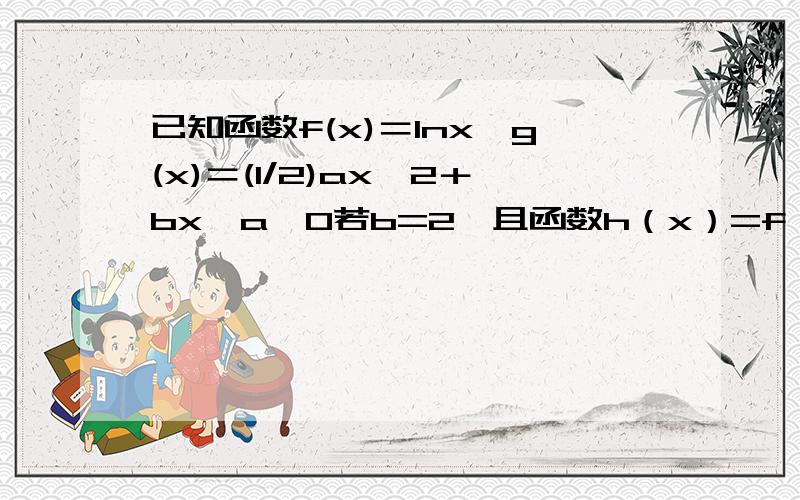已知函数f(x)=lnx,g(x)=(1/2)ax^2+bx,a≠0若b=2,且函数h(x)=f(x)-g(x)存在单调减区间,求a的取值范围.
来源:学生作业帮助网 编辑:作业帮 时间:2024/05/09 12:16:56

已知函数f(x)=lnx,g(x)=(1/2)ax^2+bx,a≠0若b=2,且函数h(x)=f(x)-g(x)存在单调减区间,求a的取值范围.
已知函数f(x)=lnx,g(x)=(1/2)ax^2+bx,a≠0
若b=2,且函数h(x)=f(x)-g(x)存在单调减区间,求a的取值范围.
已知函数f(x)=lnx,g(x)=(1/2)ax^2+bx,a≠0若b=2,且函数h(x)=f(x)-g(x)存在单调减区间,求a的取值范围.
b=2 ∴g(x)=ax²/2+2x
∴h(x)=lnx-ax²/2-2x
∴h'(x)=1/x-ax-2=(1-ax²-2x)/x(x∈(0,∞)
∵存在单调递减区间
∴h'(x)-1
a大于等于-1
已知函数f(x)=x^3-2x+1,g(x)=lnx,求F(x)=f(x)-g(x)的单调区间和极值.
已知函数f(x)=x-lnx,g(x)=lnx/x,求证f(x)>g(x)+1/2
已知函数f(x+1)= lnx,求函数f(log1/2x)定义域
已知函数f(x)=e^x(m-lnx)函数g(x)=x-lnx-f(x)'/e^x已知函数f(x)=e^x(m-lnx)函数g(x)=x-lnx-f(x)’/e^x,的最小值为1,其中f(x)‘为f(x)的导函数,求m的值
已知函数f(x)=lnX 求函数g(x)=f(x+1)---x 的最大值
已知函数f(x)=lnx,求函数g(x)=f(x+1)-x的最大值
已知函数f(x)=x^3-2x+1,g(x)=lnx 是否存在实常数k和m,使得x>0时,f(x)>=kx+m且g(x)
若函数f(x)=lnx,则g(x)=f(x+1)-x的递减区间是 已知0
已知函数f(x)=lnx,g(x)=1/2ax^2+bx(a≠0)已知函数f(x)=lnx,g(x)=(1/2)ax^2+bx,a≠0.1.若a=-2,函数h(x)=f(x)-g(x)在其定义域上是增函数,求b取值范围在1.的结论下,设函数Φ(x)=x^2+bx,x∈[1,2],求函数Φ
已知函数f(x)=(x+1)lnx-x+1.
已知函数f(x)=x^2+k|lnx-1|,g(x)=x|x-k|-2 ,其中0
已知函数f(x)=x²+lnx ,求证:当x∈(1,+∞)时,函数f(x)的图像在g(x)=2x已知函数f(x)=x²+lnx ,求证:当x∈(1,+∞)时,函数f(x)的图像在g(x)=2x³/3+x²/2的下方
已知函数f(x)=lnx-a/x,g(x)=f(x)=ax-6lnx,
已知函数f(x)=lnx.(1)求函数g(x)=f(x+1)-x的最大值(2)若对任意x>0,不等式f(x)
已知函数f(x)=mx-m/x g(x)=2lnx 若x£(1,e],不等式f(x)-g(x)
已知函数f(x)=lnx,g(x)=1/2x^2-2x,(1)设h(x)=f(x+1)-g'(x)(其中g'(x)是g(x)的导函数),求h(x)的最大值
已知函数 f(x)=lnx +2x ,g(x)=a (x 的平方+x)求(1)若a=1/2,求F (x )=f(x)-g(x )的单调区间(2)若f(x)小于等于g(x )恒成立、求a 范围
已知函数 f(x)=lnx +2x ,g(x)=a (x 的平方+x)求(1)若a=1/2,求F (x )=f(x)-g(x )的单调区间(2)若f(x)小于等于g(x )恒成立、求a 范围